

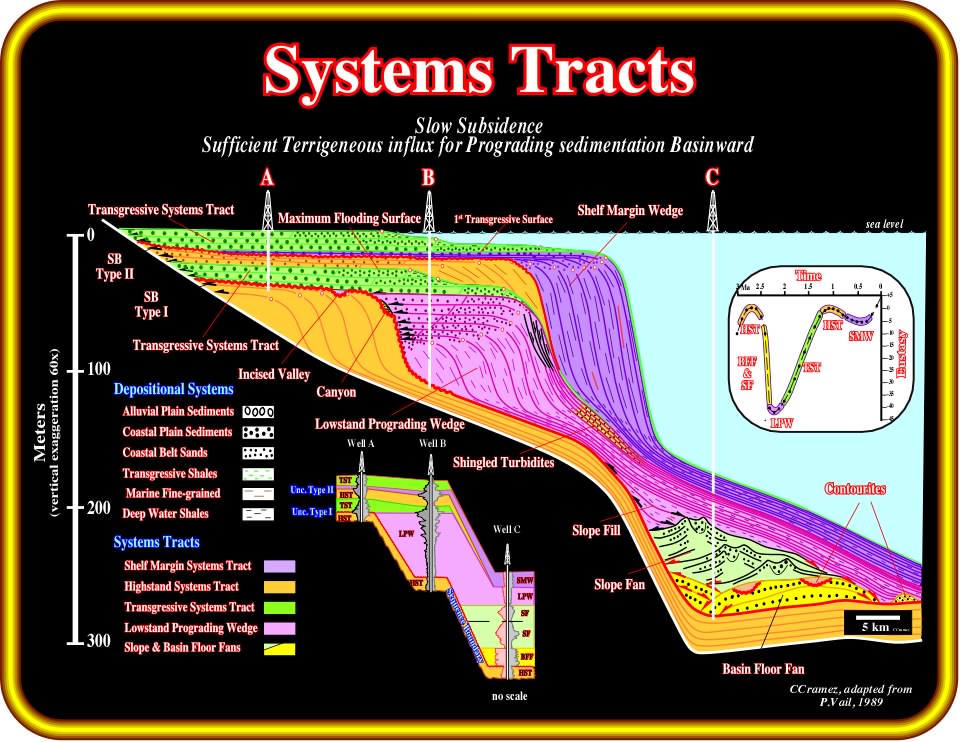
Plate 363 - On this plate are summarized the basic principles of sequential stratigraphy when performed at the hierarchic level of sequence-cycles. The stratigraphic cycles, deposited during 3rd order eustatic cycles that have a time duration ranging between 0.5 and 3 Ma, are bounded by unconformities and composed different systems tracts. The systems tracts are clearly related with the depositional environments. Landward of the shelf break, a well (A) recognizes just the transgressive (TST) and highstand systems tracts (HST). In deep water, the lowstand systems tract (LST) with basin floor fans (BFF), slope fans (SF) and lowstand prograding wedge (LPW)) is predominant, while the transgressive and highstand systems tracts are quite condensed.
Systems Tracts
1) Lowstand Systems Tract (LST) :
1.1- Basin Floor Fan (BFF) ;
1.2- Slope Fan (SF) ;
1.3- Lowstand Prograding Wedge (LPW).2) Transgressive Systems Tract (TST).
3) Highstand Systems Tract (HST).
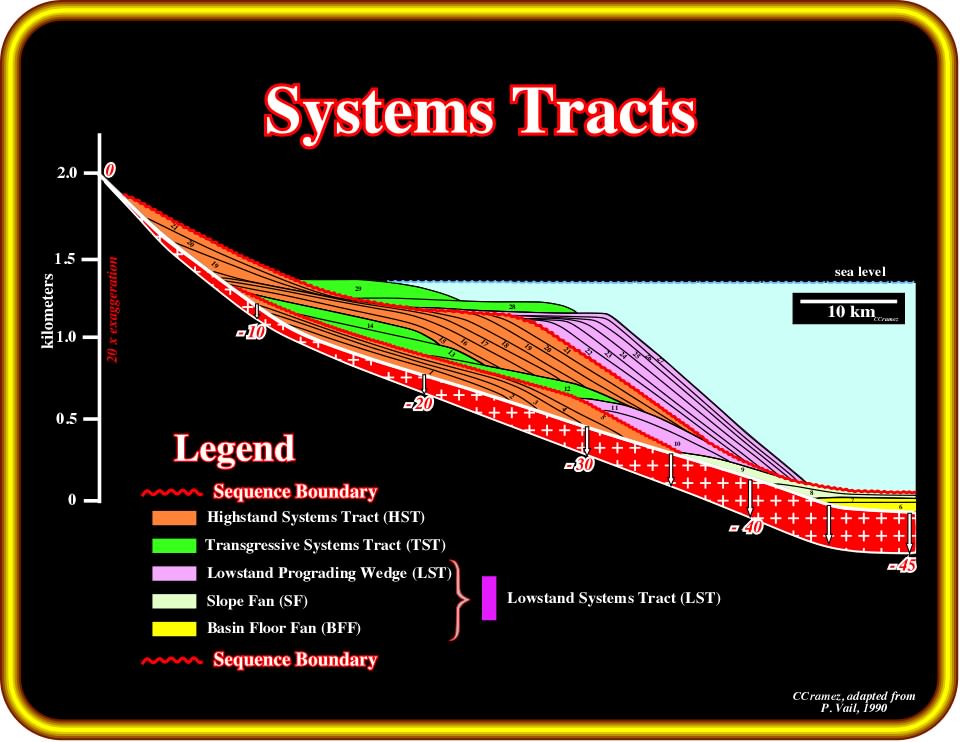
Plate 364 - On this geological model, proposed by Exxon, three stratigraphic sequence-cycles, bounded by unconformities, are illustrated. The lower sequence cycle is composed of only the highstand systems tract (HST, chronostratigraphic lines 1 to 5). The middle sequence-cycle is complete. From bottom to top, one can recognize: (i) the lowstand systems tract (LST), which is composed of a lower member (basin floor fan, BFF, 6-7), a middle member (slope fan, SF, 8-9) and an upper member (lowstand prograding wedge, LPW, 9-11), (ii) the transgressive systems tract (TST, 12-14) and (iii) the highstand systems tract (HST, 15-21). A lowstand prograding wedge (LPW, 22-27) and a transgressive systems tract (TST, 28-29) form the upper sequence cycle.
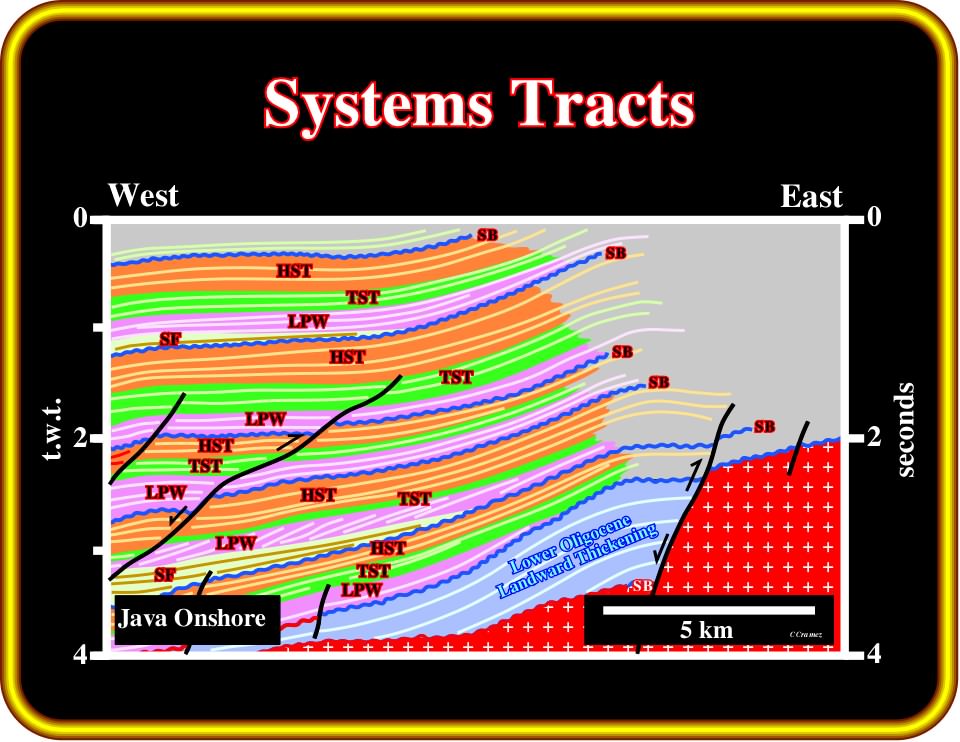
Plate 365 - This tentative interpretation of a seismic line from onshore Java, i.e., from a back-arc basin. It is interpreted in sequence-cycles. In the sag phase, above the inverted half graben, which represents a rift-type basin (rifting phase), the difference in age of the consecutive unconformities (SB) is less than 3 Ma. The stratigraphic cycles between them are sequence-cycles, in which different systems tracts can be recognized. The westward thickening of the sequence-cycles, induced by the uplifted created by the tectonic inversion, is made-up mainly by the lowstand prograding wedge (LPW) and slope fans (SF). The transgressive (TST) and highstand systems tracts (HST) are roughly isopachous.
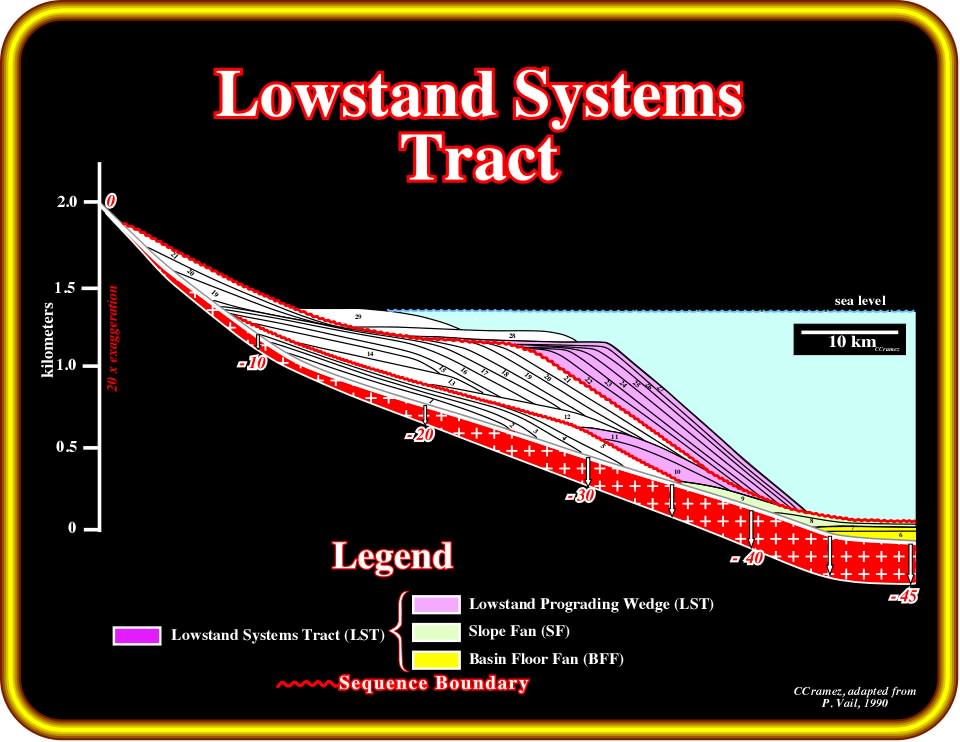
Plate 366 - Two lowstand systems tracts are easily recognized on this geological model (Plate 364). The lower one (between the chronostratigraphic lines 6 and 11), located in the middle sequence-cycle, is complete. The three stratigraphic members are present: (i) the basin floor fan (BFF), between time lines 6 and 7, (ii) the slope fan (SF), between time lines 8 and 9 and (iii) the lowstand prograding wedge (LPW), between the chronostratigraphic lines 10 and 11. Basin floor fans are located seaward of the toe of the continental slope. Slope fans are located at the toe of the continental slope and lower slope. Lowstand prograding wedges are located between the shelf break (lower sequence cycle boundary) and the toe of the continental break. Seaward of the continental slope, lowstand prograding wedges are represented mainly by stratigraphic condensed sections.
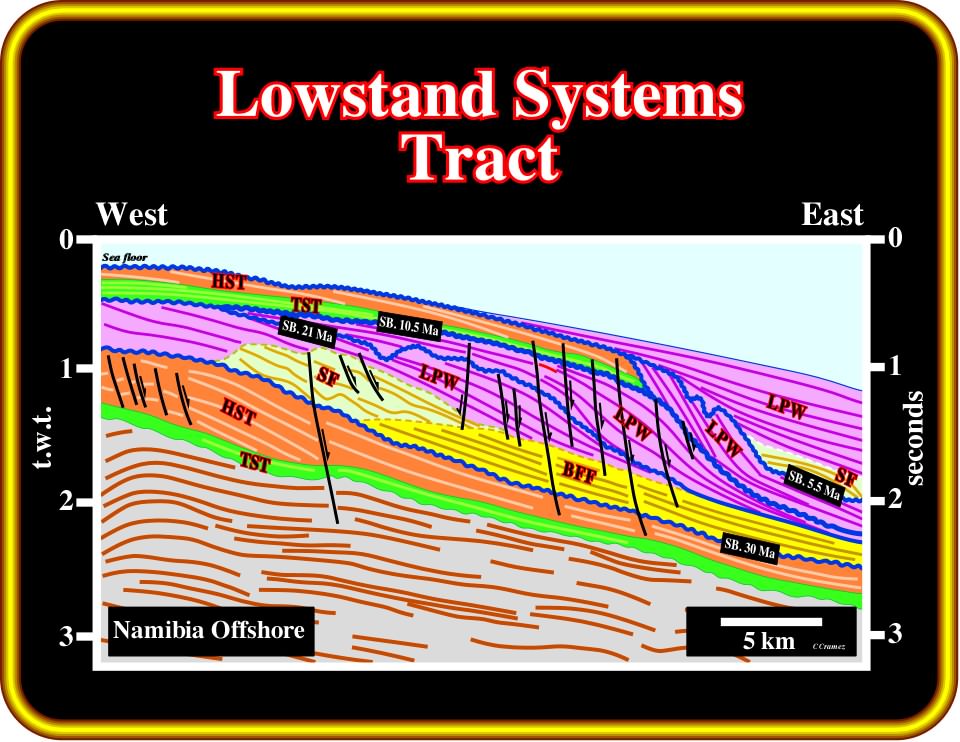
Plate 367 - This tentative interpretation of seismic line from the offshore Namibia (Atlantic-type divergent margin), in which lowstand deposits are predominant, can be used to illustrate the three stratigraphic members of the lowstand systems tract: (i) Basin Floor Fan (BFF ; (ii) Slope Fan (SF) and (iii) Lowstand Prograding Wedge (LPW). Canyons (SC) and incised valleys (IV) developed during relative sea falls and filled during the relative sea level rises are also easily recognized. The proposed interpretation is not at the level of the sequence cycle. The age difference between the picked unconformities is higher than 3-5 My. The sedimentary intervals between the unconformities are not associated with 3rd order eustatic cycles. Subtle unconformities exist between them. The proposed lowstand prograding wedges correspond in fact to lateral and vertical stacking of incomplete sequence cycles composed just by lowstand prograding wedges.

Plate 368 Three geological settings can be recognized in lowstand systems tracts: (i) Deep-water setting, (ii) Ramp setting and (iii) Growth-fault setting. In a deep-water setting, as illustrated above, the morphology of the lower sequence cycle boundary is similar to that of a depositional surface. The three main segments, individualized by a shelf break and the lower slope break, are: (i) the coastal plain, (ii) the continental slope and (iii) the abyssal plain. The majority of the depositional systems are located seaward of the shelf break. Just incised valley fills (IVF) are located landward of the shelf break.
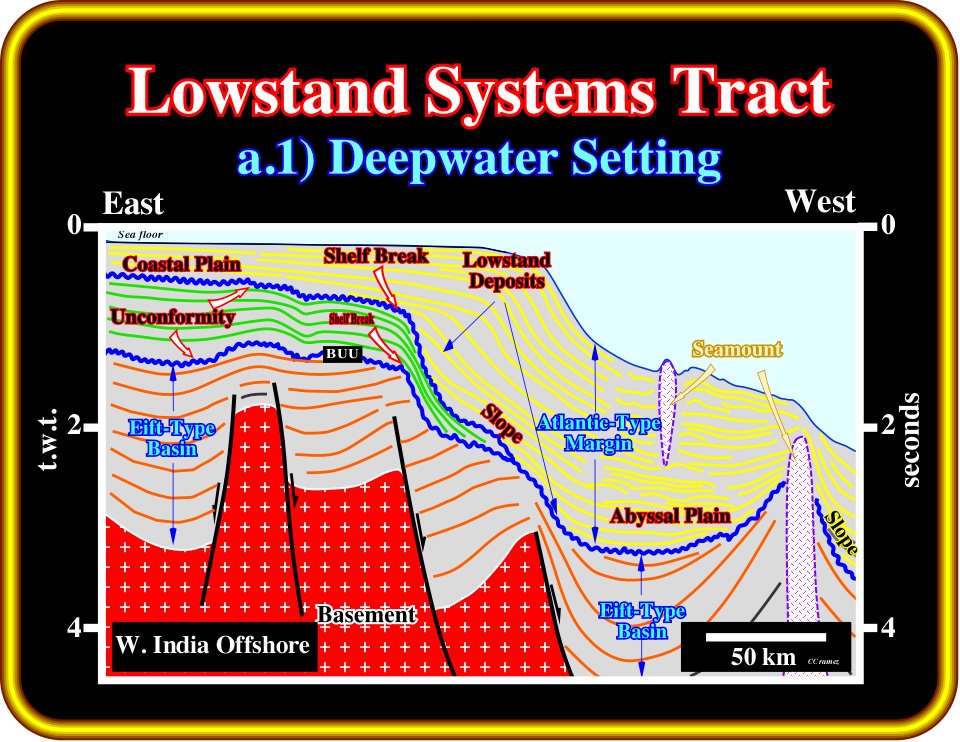
Plate 369 - On this tentative interpretation a west offshore of India, the breakup unconformity (BUU), which separates the rift-type basins from the Atlantic-type divergent margin, is quite easy to recognize. In the central and western part of the seismic line, the BUU is roughly coincident with another well-marked unconformity. On the eastern part, i.e., landward, both unconformities are quite well individualized. The morphologies of these unconformities, and particularly that of the younger one, are characterized by marked coastal plains, slopes and abyssal plains. Seaward of the pristine shelf break, where deposition takes place, such morphologies (deep-water setting) allowed deposition of deep marine turbidite deposits (basin and slope fans) and wide lowstand prograding wedges. Erosion took place on the exhumed platforms with the development of incised valleys, which were filled during the last stages of the lowstand prograding wedges, in which the coastal onlap fossilized the major break of the lower sequence cycle boundary.

Plate 370 - In a lowstand ramp setting, as depicted on this sketch, the morphology of the lower sequence cycle boundary is quite different from that of a deep-water setting. The pristine shelf break of the lower unconformity is quite difficult to locate. The morphology of the lower boundary is rather flat. In such geological conditions, the thickness and paleowater depth of the lowstand systems tract, deposited seaward of the initial shelf break, are smaller than in a deep-water setting. On the contrary, the coastal encroachment (lateral component of coastal onlap) is much higher. The filling of the incised valleys, developed landward of the exhumed shelf, takes place during the last stages of the lowstand prograding wedge. The incised valleys (do not confuse incised valley (IV) with incised valley fill (IVF)) are totally filled, and so fossilized, when the coastal onlap reached the pristine shelf break. At such time (just before the first transgressive surface) a new shelf break is developed seaward, near the depositional coastal break of the upper lowstand prograding wedge (basin without platform).
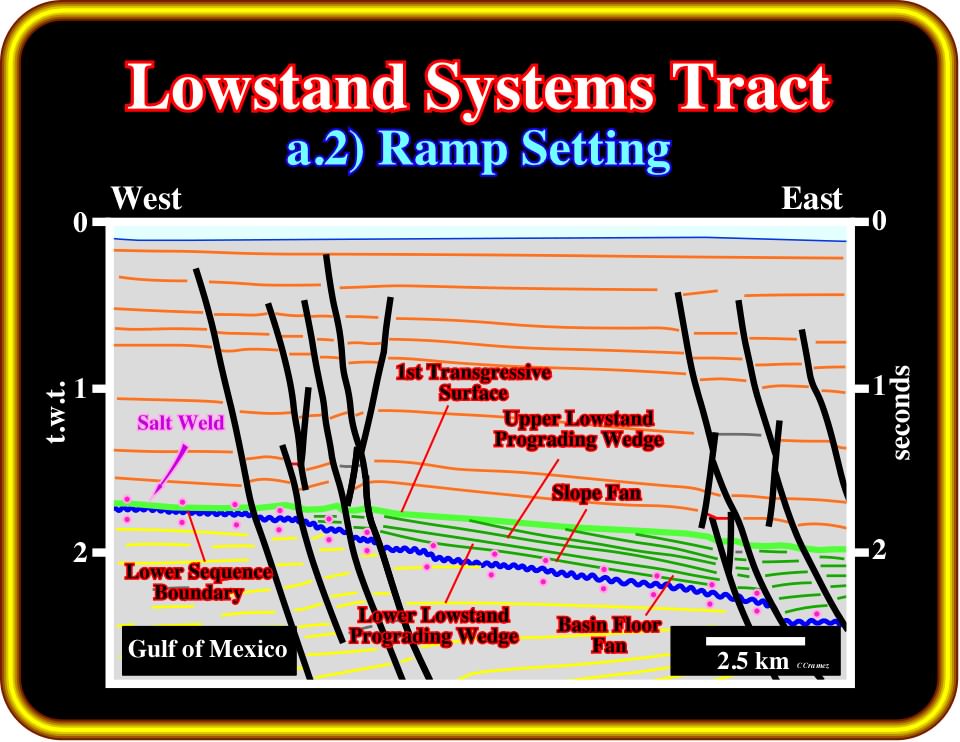
Plate 371- Lowstand ramp settings are frequent in the Gulf of Mexico. They are often associated with salt tectonics and particularly with allochthonous salt layers. As illustrated in this tentative interpretation, the salt induced a tectonic disharmony (landward termination of a salt weld, in red) created an unconformity, which corresponds to a lower sequence cycle boundary, above which, a lowstand systems tract was deposited in a ramp setting. The morphology of the unconformity is quite flat, and so, the location of the initial shelf break is quite difficult to locate. Similarly, the differentiation between the three members (systems tracts) composing the lowstand systems is not obvious. On the contrary, the landward pinchout of the lowstand systems tract, defined between the lower sequence boundary and the 1st transgressive surface, is quite evident, as displayed above.
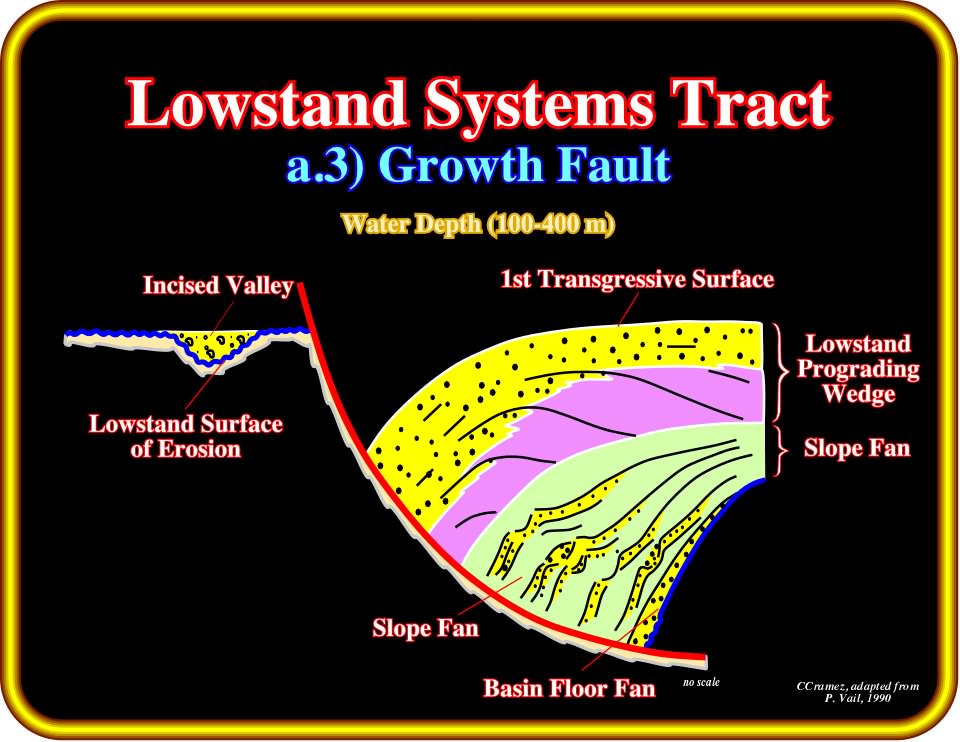
Plate 372 - Another lowstand geological setting is that associated with growth faults. As pictured above, very often, lowstand systems tracts are located on the hangingwall of the growth faults. On the footwall, they are absent or just represented by the uppermost part of the upper lowstand prograding wedge. Besides, the systems tracts, i.e., (i) the basin floor fan (BFF), (ii) the slope fan (SF) and (iii) the lowstand prograding wedge (LPW), which form the lowstand systems tract (LST), thicken strongly toward the growth fault plane, where, due to the higher compensatory subsidence, the space available (accommodation) is higher. The compensatory subsidence is induced by flowage of the associated mobile substratum, generally salt (evaporites) or shale. Stratigraphic traps (with a strong structural component) are associated with this geological setting, particularly with the channel levee complexes of the slope fans or the basin floor lobes.

Plate 373- On this tentative interpretation of a seismic line from the Gulf of Mexico, lowstand growth fault settings are readily recognized. The flowage of allochthonous salt created a synsedimentary extensional tectonic regime in the overlying sediments. Such a regime induced not only different trends of growth faults, striking perpendicularly to the salt flowage direction, but a compensatory subsidence as well. As displayed, between consecutive growth faults, lowstand systems tracts were deposited. They show a strong thickening toward the fault planes suggesting syntectonic deposition. The isopachous intervals are deposited during periods of salt tectonic inactivity. Transgressive and highstand systems tracts seem to be absent. On the contrary, near the top of the faulted blocks (hanging wall), erosional features are often present suggesting subaerial environments, particularly during the upper lowstand prograding wedges. The identification of the different members of the lowstand systems tract is often possible (see later) depending on the compensatory subsidence, terrigeneous influx and seismic resolution.